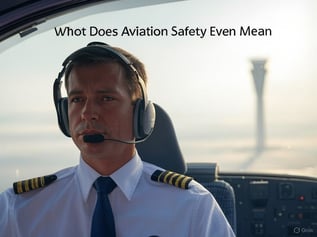Why Talk About "Aviation Safety?"
The United States' National Airspace System (NAS) handled between 54 million and 56 million takeoffs and landings in calendar year 2024 (January 1 to December 31). Handling such air traffic volume safely is in the interest of everyone, even for those who do not fly.
Aviation safety refers to measures, practices, and systems designed to minimize risks and prevent harm in air travel and aircraft operations. Aviation safety considers all types of flights, including:
- commercial,
- private, or
- military operations.
Four Runway Incursions Per Day!
In the United States, there were 1,756 runway incursions reported in fiscal year 2023, according to data from the Federal Aviation Administration (FAA). This figure covers the period from October 1, 2022, to September 30, 2023. Documented runway incursions reflect incidents involving the incorrect presence of an aircraft, vehicle, or person on a runway or protected area. This total averages about four incursions per day.
"Aviation Safety" ensures that flights can take off, fly, and land without incidents like
- crashes,
- injuries, or
- fatalities.
Related Aviation Safety Articles
- Are Aviation SMS Implementations Different for Airports, Airlines, MROs?
- How to Start an Aviation SMS Implementation - With Resources
- 6 Questions & Downloads for Starting an Aviation SMS Implementation
Goal of Aviation Safety
Aviation safety's goal is to protect passengers, crew, ground personnel, and even unrelated people on the ground, while keeping aircraft and infrastructure intact. Aviation safety's scope exceeds the human aspects and also includes protecting equipment, property and the environment.
At its core, aviation safety tackles the inherent dangers of flying:
- high speeds,
- extreme altitudes,
- complex machinery, and
- unpredictable factors like weather.
Aviation safety involves everything from designing reliable planes to
- training pilots,
- maintaining equipment, and
- enforcing strict operating regulations.
We may think of aviation safety as a web of efforts to stop things from going wrong, whether the event is related to
mechanical failures;
- human error;
- runway debris; or
- bird strikes.
Aviation Safety Covers Much More Than Root Causes
Aviation safety not only focuses on root causes, but also manages the damage should these hazardous events manifest themselves.
For example, aviation safety encompasses:
- Preventing Accidents: Rules like using approved aircraft parts and regular maintenance checks (e.g., FAA mandates inspections every 100 flight hours for small planes) catch issues before they escalate.
- Reducing Severity: Features like specialized glass in cockpits, crash-resistant seats or emergency evacuation procedures limit damage if something fails.
- Systemic Oversight: Agencies like the NTSB investigate crashes to figure out why a plane went down—like the 2023 Alaska Airlines door plug blowout—and recommend fixes.
Related Aviation Safety Articles
- How to Define Severity and Likelihood Criteria
- How to Assign Severity and Likelihood to Issues When Assessing Risk
- How to Justify Severity of Risk Assessments - Best Practices
Safety Considers More Than Planes and Pilots
Aviation safety considers not just hardware, aircraft and pilots; it’s also
- Air traffic control keeping planes from colliding,
- Weather forecasting to dodge storms, and even
- Cybersecurity to stop hackers from messing with navigation.
In conclusion, aviation safety is the art and science of making flying as close to risk-free as possible, balancing technology, human skill, and constant vigilance. It’s why you can board a plane and reasonably expect to land in one piece.
Aviation safety is managed formally using sophisticated database technology. SMS Pro is considered a leader in managing aviation safety requirements around the world.
To see SMS Pro in action, watch our online demo videos or request a live demo below:
Request live demo below:





